Safeway Inc.
|
It's Just Better | |
| Subsidiary | |
| Industry | Retail / Grocery |
| Founded |
April 1915 American Falls, Idaho, U.S. |
| Founder | Marion Barton Skaggs |
| Headquarters | Pleasanton, California, U.S. |
Number of locations | 1,335 |
Key people |
Robert G. Miller (Chairman & CEO) Bob Gordon (EVP & General Counsel) |
| Products | Bakery, dairy, delicatessen, dry cleaning, frozen foods, fuel, grocery, lottery, pharmacy, photographic processing, produce, meats, snack food, liquor, flowers, and Western Union |
| Services | Supermarket |
Number of employees |
|
| Parent | Albertsons |
| Website |
www |
Safeway, Inc. is an American supermarket chain founded in 1915. It is a subsidiary of Albertsons, having been acquired by private equity investors led by Cerberus Capital Management in January 2015. Safeway's primary base of operations is in the western and central United States,[1] with some stores located in the Mid-Atlantic region of the Eastern Seaboard. The subsidiary is headquartered in Pleasanton, California with parent company headquarters in Boise, Idaho.
History
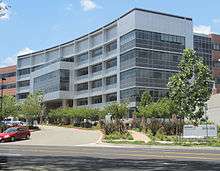
In April 1915, Marion Barton Skaggs purchased his father's 576-square-foot (53.5 m2) grocery store in American Falls, Idaho, for $1,089. The chain, which operated as two separate businesses, Skaggs Cash Stores and Skaggs United Stores, grew quickly, and Skaggs enlisted the help of his five brothers to help grow the network of stores. M.B.'s business strategy, to give his customers value and to expand by keeping a narrow profit margin, proved spectacularly successful. By 1926, he had opened 428 Skaggs stores in 10 states. M.B. almost doubled the size of his business that year when he merged his company with 322 Safeway stores and incorporated as Safeway, Inc.[2]
The original slogan was "an admonition and an invitation" to "Drive the Safeway; buy the Safeway". The point of the name was that the grocery operated on a cash-and-carry basis — it did not offer credit, as grocers traditionally had done. It was the "safe way" to buy because a family could not get into debt via its grocery bill (as many families did at the time, especially during the Great Depression).
In 1926, Charles E. Merrill, the founder of the Merrill Lynch brokerage firm, saw an opportunity to consolidate the West Coast grocery industry. Towards this end, he purchased the 322-store Safeway chain of W.R.H. Weldon, who wished to exit retailing and concentrate on wholesale. Then, in June 1926, Merrill offered Skaggs either $7 million outright or $1.5 million plus 30,000 shares in the merged firm. Skaggs took the latter.[3] On July 1, 1926, Safeway merged with the 673 stores from Skaggs United Stores of Idaho and Skaggs Cash Stores of California. On completion of the Skaggs/Safeway merger, M. B. Skaggs became the Chief Executive of the business.[4] Two years later, M.B. listed Safeway on the New York Stock Exchange. In the 1930s, Safeway introduced produce pricing by the pound, adding "sell by" dates on perishables, nutritional labeling, and some of the first parking lots.
The merger instantly created the largest chain of grocery stores west of the Mississippi.[5] In the 1930s, Charles E. Merrill temporarily left Merrill Lynch to help manage Safeway. At the time of the merger, the company was headquartered in Reno, Nevada. In 1929, it was relocated to a former grocery warehouse in Oakland, California. Safeway headquarters remained there until the move to Pleasanton, California in 1996.
Expansion
The initial public offering price of Safeway stock was $226 in 1927. A five for one split in 1928 brought the price down to under $50. Over the next few years, Charles Merrill, with financing supplied by Merrill Lynch, then began aggressively acquiring numerous regional grocery store chains for Safeway in a rollup strategy. Early acquisitions included significant parts of Piggly Wiggly chain as part of the breakup of that company by Merrill Lynch and Wall Street.
| Year | Firm | # of stores | Location |
|---|---|---|---|
| 1926 | H.G. Chaffee | grocery stores | Southern California |
| 1926 | Skaggs Cash Stores | 679 grocery stores | Idaho |
| 1926 | Skaggs United Stores | (in above) | California |
| 1928 | Arizona Grocery/Pay'n Takit Stores | 24 grocery stores; 24 meat markets | Arizona |
| 1928 | Newway Stores | 15 grocery stores; 11 meat markets | El Paso, Texas |
| 1928 | Sanitary Grocery (incl. some Piggly Wiggly) | 429 grocery stores; 67 meat markets | Washington D.C. and Virginia |
| 1928 | Eastern Stores Inc. | 67 grocery stores; 127 meat markets | Baltimore, Maryland |
| 1928 | Piggly Wiggly Pacific | 91 grocery stores; 84 meat markets | Oakland, California |
| 1928 | Bird Grocery Stores (including some Piggly Wiggly) | 224 grocery stores; 210 meat markets | Missouri, Texas, Arkansas, Iowa, Kansas, Nebraska |
| 1929 | Piggly Wiggly West | 91 grocery stores; 84 meat markets | Northern California, Hawaii, Colorado |
| 1929 | Sun Grocery | 91 grocery stores; 84 meat markets | Tulsa, Oklahoma |
| 1931 | MacMarr Stores | grocery stores | Los Angeles |
| 1936 | Stores from Kroger | 53 grocery stores | Oklahoma |
| 1941 | Daniel Reeves | 498 grocery stores | New York |
| 1941 | National Grocery | 84 grocery stores | New Jersey |
| 1958 | Thriftway Stores (Iowa) | 30 grocery stores | Iowa |
Most transactions involved the swap of stock certificates, with little cash changing hands. Most acquired chains retained their own names until the mid-1930s.
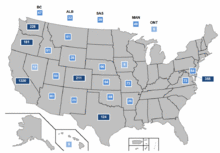
In 1929, there were rumors of a Safeway-Kroger merger.[6]
The number of stores peaked at 3,400 in 1932, when expansion ground to a halt. The Great Depression had finally impacted the chain, which began to focus on cost control. In addition, numerous smaller grocery stores were being replaced with larger supermarket stores. By 1933, the chain ranked second in the grocery industry behind The Great Atlantic & Pacific Tea Company and ahead of Kroger.
In 1935, Safeway sold its nine stores in Honolulu, Hawaii "...because of the inconvenience of proper supervision."[7] Also in 1935, independent groceries in California convinced the California legislature to enact a progressive tax on chain stores. Before the act took effect, Safeway filed a petition to have the law put to a referendum. In 1936, the California electorate voted to repeal the law.
In 1936, Safeway introduced a money back guarantee on meat.[8]
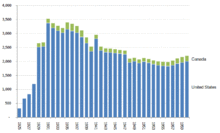
International expansion
| Country | Year | # of stores |
|---|---|---|
| Canada | 1929 | 213 (2013) |
| United Kingdom | 1962 | 131 (1986) |
| Australia | 1962 | 123 (1984) |
| West Germany | 1963 | 35 (1984) |
| Mexico | 1981 | 137 (2007) |
| Saudi Arabia | 1982 | 6 (1984) |
| Jordan | 2003 | 6 (2009) |
| Kuwait | ? | ? |
The company expanded into Canada in 1929 with 127 stores (which became Canada Safeway Limited and which was sold to Sobeys in 2013);[9] into the United Kingdom in 1962 (which became Safeway plc); into Australia in 1963 (which became Safeway Australia); and into Germany in 1964. The company also has operations in Saudi Arabia and Kuwait in a licensing and management agreement with the Tamimi Group during the 1980s. In 1981, it acquired 49% of Mexican retailer Casa Ley.
Safeway usually achieved international expansion by acquiring one or more small chains in a given country. It expanded into Saudi Arabia and Kuwait, however, through a joint venture. This initial nucleus of stores received Safeway systems and technology and then expanded organically. International chains acquired include:
| Year | Firm | # of stores | Location |
|---|---|---|---|
| 1929 | ? | 9 grocery stores | Canada |
| 1935 | Piggly Wiggly (Canada) | 179 stores | Canada |
| 1962 | John Gardner Limited | 11 stores | United Kingdom |
| 1963 | Pratt Supermarkets | 3 stores | Melbourne, Australia |
| 1963 | Mutual Stores | ? stores | Australia |
| 1964 | Big Bär Basar (Big Bear Bazaar) | 2 stores | West Germany |
| 1980 | Jack the Slasher | 31 stores | Queensland, Australia |
| 1981 | 49% of Casa Ley | ? stores | Mexico |
1940s-1970s
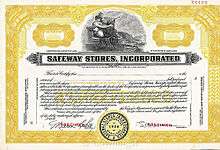
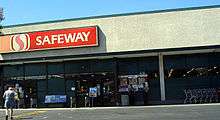
In 1941, Marion B. Skaggs retired from the Safeway board of directors.[4]
In 1947, the company's sales exceeded $1 billion for the first time. By 1951, total sales had reached nearly $1.5 billion. The company adopted the S logo, which it still uses, in 1962.
In 1955, Robert A. Magowan became Chairman of the Board of Safeway. Magowan had married Charles Merrill's daughter, Doris. Magowan also assumed the title of President in 1956. He remained President until 1968, and a member of the board until 1978.
In 1959, Safeway opened its first store in the new state of Alaska—the first major food retailer to enter that market. The company opened three stores in Anchorage and one in Fairbanks over the next several years. The store in downtown Fairbanks was built on the site of a red-light district, known as The Line, which operated for close to a half century. Most of these stores were in buildings constructed by Anchorage real estate developer Wally Hickel, who later became governor of Alaska and U.S. Secretary of the Interior.
Also in 1959, the firm also opened the first "marina-style" store on the Marina in San Francisco. Hundreds of stores in this iconic, barrel-vaulted-roof style opened during the next decade.[10]
In 1961, the company sold its New York operations to Finast.[11] In 1963, Safeway again opened stores in Hawaii, having exited this market in 1934.[12] It leased one store in Culver City to animator/filmmaker Don Bluth, who used it as a theater until 1967.
In 1969, Safeway entered the Toronto market in Canada and the Houston market in Texas through opening new stores, rather than by acquisition. The firm ultimately failed against entrenched competition in both these markets.
In 1977, Safeway management instituted a program to fight counterfeit $100 bills by, among other things, telling employees that bills that lacked the words "In God We Trust" were counterfeit. Because Safeway had not sufficiently investigated the history of $100 bills, it was unaware that some bills still in circulation did not have the phrase. Eventually, an innocent shopper was incorrectly reported to Oakland, California police for passing a "counterfeit" bill. he was arrested and strip-searched before Oakland police contacted the Treasury Department and realized the error. The 1981 jury verdict of joint and several liability for $45,000 against Safeway Stores and the City of Oakland was upheld in full by the Supreme Court of California on December 26, 1986.[13]
In 1979, Peter Magowan, son of Robert Magowan and grandson of Charles Merrill, was appointed Chairman and CEO of Safeway. Magowan managed Safeway for the next 13 years—presiding over the dramatic decline of the firm in terms of store numbers
1980s: Takeover and sell-offs
Following a hostile takeover bid from corporate raiders Herbert and Robert Haft, the chain was acquired by Kohlberg Kravis Roberts (KKR) acting as a white knight in 1986. With the assistance of KKR, the company was taken private and assumed tremendous debt. To pay off this debt, the company began selling off a large number of its operating divisions.
| Year | Division sold | # of stores | Sale price | Buyer | Outcome |
|---|---|---|---|---|---|
| 1983 | Omaha/Sioux Falls | 64 stores | n/a | Multiple buyers including Hy-Vee & Fareway | Stores continue to operate as Hy-Vee (Omaha/Lincoln/Sioux Falls) and Fareway (Sioux City, IA) |
| 1985 | Southern Ontario | 22 stores | n/a | Oshawa Group | Oshawa acquired by Sobeys in 1998 |
| 1985 | West Germany | 36 stores | n/a | Meierei C Bolle | Stores now part of Edeka |
| 1987 | Dallas | 141 stores | n/a | Unable to sell whole division | Sold in pieces to Kroger, Brookshire's, Tom Thumb Food & Pharmacy (which is now owned by Safeway), Minyard Food Stores and Furr's; some stores shuttered |
| 1987 | Salt Lake City | 60 stores | $75m | Borman's (Detroit) | Borman's sells stores in pieces at under book value in 1988 to Flemings (supermarkets) & Albertsons; Borman's acquired by A&P late 1988 |
| 1987 | El Paso | 59 stores | $140m | Furr's Supermarkets (see Roy Furr) | Firm hits financial difficulties; MBO of some stores; other sold; bankruptcy in 2001 |
| 1987 | Oklahoma | 106 stores | n/a | MBO by management and Clayton & Dubilier forming Homeland (supermarket) | Firm listed then goes into bankruptcy in 1996. Later it was bought by and became a subsidiary of Associated Wholesale Grocers. |
| 1987 | Safeway UK | 121 stores | US$1b | Argyll Foods | Stores continued to trade under Safeway name until 2005, when they were acquired by Morrisons |
| 1988 | Kansas City | 66 stores | n/a | Morgan Lewis Githens & Ahn/W S Acquisition Corp. | Renamed Food Barn; bankruptcy 1994; stores sold to Associated Wholesale Grocers, which either closed or divested them to their members. |
| 1988 | Little Rock | 51 stores | n/a | Acadia Partners | Renamed Harvest Foods; bankruptcy in 1995; stores sold off; some now part of Associated Wholesale Grocers after the demise of Affiliated Foods Southwest |
| 1988 | Houston | 99 stores | $174.6m | MBO with Duncan Cook and Co. and the Sterling Group | Renamed AppleTree Markets; bankruptcy 1992; stores sold to competitors |
| 1987 | Safeway Australia | 135 stores | $124m | Woolworths Limited Australia | Some stores continued to trade under Safeway name until 2008 (only within state of Victoria). All stores were gradually rebranded to Woolworths. |
| 1988 | Southern California | 172 stores | $408m | Vons | The $408m that Safeway acquired in the deal consisted of $325m in cash and 30 percent interest in Vons;[14] Safeway later acquired 100 percent ownership in 1997 |
The divested domestic divisions of Safeway proved to be poisoned chalices for almost all those who acquired them. Essentially every purchasing entity hit financial troubles and either went bankrupt or was later acquired. (Hy-Vee and Fareway are the exceptions with the locations it acquired, having made them work)
The international stores were more successful for their acquirers. UK stores, Safeway plc, were sold to Argyll Foods, which itself was ultimately absorbed by Morrisons in 2004. Safeway Australia was sold to the Australian-based Woolworths Limited in 1985.
Safeway sold its stores in Southern California, including those in established markets like Los Angeles and San Diego, to Vons in 1988 in exchange for a 30 percent interest in the company. Safeway also diminished operations in Fresno, Modesto, Stockton, and Sacramento. Save Mart Supermarkets purchased the few remaining Fresno Safeway stores in 1996.
Many stores in the Eastern Division were also closed or sold in the 1987-89 timeframe, including many recent additions in the DelMarVa Eastern Shore area.
Safeway's national presence was now reduced to several western states and Northern California, plus the Washington, D.C. area. Altogether, nearly half the 2,200 stores in the chain were sold.
1990s
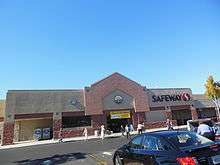
The company was taken public again in 1990.
Safeway Jordan was sold to the Masri family in 1991. In December 2003, the Masri family sold it to The Sultan Center of Kuwait.
In the late 1990s, Safeway began to again aggressively acquire regional chains, including Randall's Food Markets in Texas, Carrs in Alaska, and Dominick's in Illinois. The buyout of Randall's marked Safeway's return to Texas ten years after the original stores in Houston were sold to AppleTree and several Dallas stores were sold to Tom Thumb, which was later acquired by Randall's. In 1997, after being a minority owner since 1988, Safeway exercised its option to acquire full control of Vons in Southern California.
In 1999, the Safeway chain began selling gasoline at some of its new stores. It began operation of gasoline stations when it purchased the Randall's chain.[15]
2000s and beyond
In 2000, Safeway started grocery delivery operations.[16]
In 2001, Safeway acquired the family-owned Genuardi's chain, with locations in Pennsylvania, New Jersey, and Delaware. Safeway also created the subsidiary Blackhawk Network, a prepaid and payments network, a card-based financial solutions company, and a provider of third-party prepaid cards.
In October 2003, members of the United Food and Commercial Workers at Vons stores in Southern California called a strike. The strike (and concurrent lockout at Albertsons and Ralphs) lasted until the end of February 2004.
In July 2007, the company stock rose on speculation that Sears Holdings Corporation was seeking to purchase Safeway.[17]
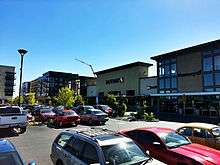
In 2012, the company dissolved the Genuardi's chain in suburban Philadelphia through a combination of store selloffs and closures. Giant acquired 15 of the chain's stores and made an offer for a 16th which was instead sold to a local chain as part of an antitrust settlement. Weis also bought three Genuardi's locations. A number of unprofitable Genuardi's units also had closed in 2010 and 2011 as their leases expired. Earlier, Zagara's, a small chain of upscale, gourmet supermarkets started by Genuardi's in 1990 was also shuttered in 2000, immediately following its parent company's acquisition by Safeway. The only Genuardi's in the northern half of New Jersey also closed soon after the merger with Safeway, and a location in Bensalem, Pennsylvania was sold to ShopRite in 2004.
Genuardi's in Wilmington, Delaware were converted to the Safeway name in 2004 due to legal issues stemming from a union contract signed by the management of early Safeway stores in Delaware that closed in 1982. The current Safeway locations in Delaware are served by division offices in the Baltimore–Washington metropolitan area, where Safeway has long been the dominant grocer. However, the majority of Safeway stores operate in the Western United States, where the chain originated.
On January 8, 2011 US congressperson Gabrielle Giffords survived an assassination attempt at a Safeway in a Tucson, Arizona suburb in which a lone gunman killed six and injured 13.[18]
In 2011, Safeway signed an agreement with UNFI, for the distribution to all of Safeway's banners in the United States for non-proprietary natural, organic and specialty products effective October 2011.[19]
On June 12, 2013, Sobeys announced it would acquire Safeway's operations in Canada for CDN$5.8 billion, subject to regulatory approval. The move will bolster its presence in Western Canada, where Safeway was predominant.[20] Sobeys completed the sale five months later while keeping the Safeway banner on its newly acquired stores while changing private labels to be more inline with those used by its new parent.[21]
In October 2013, Safeway announced that it would cease operating Dominick's stores in the Chicago area by early 2014.[22][23] The announcement spurred its competitors to seek employees and desirable store locations they could purchase.[24] One location would remain open in Bannockburn, Illinois until January 25, 2014.[25]
On February 19, 2014, Safeway began to explore selling itself. On March 6, 2014 Cerberus Capital Management (which also owns rival grocery chain Albertsons) announced it would purchase Safeway for $9.4 billion in a deal expected to close in the 4th quarter of the year.[26]
In January 2015, Bellingham, Washington headquartered grocery chain, Haggen announced it would buy 146 Vons, Albertsons and Pavilions stores across Washington, Oregon, California, Nevada, and Arizona as part of anti-monopoly requirements following the merger. Some of the major metropolitan areas affected were Los Angeles, Portland, Phoenix, Tucson, San Diego, Bakersfield, Seattle, and Las Vegas.[27]
On January 30, 2015, the merger between Safeway and Albertsons was finalized.[28]
On January 11, 2016, it was announced that the three remaining Albertsons stores in Florida, located in Largo, Altamonte Springs and Oakland Park, would be re-bannered as Safeway; this marks the first time that the Safeway brand would exist on a supermarket operation in Florida.[29]
On September 7, 2016, it was announced that 9 Albertsons stores in the Denver Metro area would be re-bannered as Safeway since Safeway is the stronger brand in the Denver Area [30] The name change happened October 19, 2016.
Current operations
As of 2014, Safeway had a total of 1,335 stores in the United States and 195 in Mexico with its partnership with Casa Ley. The largest concentration of Safeway branches is in Washington with 168 stores and then Colorado with 115.
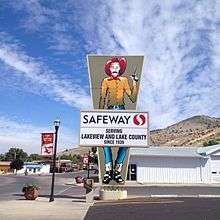
Chains
- Carrs-Safeway (Alaska)
- Pak 'n Save (California)
- Pavilions (Southern California)
- Randall's (Texas)
- Safeway (Alaska, Arizona, Northern California, Colorado, District of Columbia, Delaware, Florida, Hawaii, Idaho, Maryland, Montana, Nebraska, Northern Nevada, New Mexico, Oregon, South Dakota, Virginia, Washington, Wyoming)
- Tom Thumb (Texas)
- Vons (Southern California and Southern Nevada)
Former
- Dominick's (Northeast Illinois) — closed December 2013
- Genuardi's (Pennsylvania, one store was open in Audubon, which closed in 2015)
- Simon David (Texas)
Private brands
"Signature Select" is the company's signature private label that offers an upscale range of products, a sublabel "Primo Taglio" is used for more upscale deli products and "Lucerne" is the main dairy line. In 2006, Safeway introduced a new line, with organically grown and processed line of products named "O Organics." After its acquisition by Albertsons, the combined company adopted Safeway's private label brand program, previously named "Safeway Select."
Some of the brands in use are:
- Basic Red/Value Red — Mostly paper products, but includes large tubs of ice cream and sandwich breads and buns.[31]
- Bright Green — Environmentally friendly cleaning products[32]
- Butcher's Cut, The — Secondary meat brand used for prepackaged cold cuts and raw meats
- Captains Choice — Seafood brand (Alaska stores only since June 2013)
- Country Hearth - A Lucerne manufactured line of bread similar to Oroweat
- Conti Gourmet Coffee. A gourmet goffee company, base Coppell, Texas
- Dairy Glen — A second dairy brand, it is also used for the two gallon tubs of ice cream.
- Deli Counter, The — A secondary deli brand used mainly for cold cuts
- Diablo Creek — Wine
- Eating Right — Brand used for healthier eating using labels such as low fat, low sodium, etc.
- Firefly Ridge — Wine
- Gourmet Meat Shoppe — Frozen meat products
- In Kind — Hygiene products, beginning October 2010
- Jerseymaid — A carryover dairy brand from Safeway's acquisition of Vons, still used due to its reputation
- Lucerne — The main dairy brand, used for ice cream, cheese, yogurt, and milk[31]
- Manor House — Another frozen meat line used for turkeys during the holidays
- Mom to Mom — A full line of baby products[33]
- O Organics — Line of organic products
- Open Nature — A line of 100% natural foods, beginning January 2011
- Oven Joy — Bread brand that is neither Safeway, O Organics, Eating Right nor Safeway Select
- Pantry Essentials — Line of affordable food and household items (Household Items discontinued in the Denver division Aug 1, replaced by Fiora brand products)
- Primo Taglio — The upscale deli cold cut brand[31]
- Priority — Pet care brand.[31]
- Produce Stand, The — Prepackaged produce such as baby carrots, salads, and raisins
- Ranchers Reserve — The upscale meat brand.[31] (Retired July 2015 replaced with USDA Choice, in use from 2001-2015)
- Refreshe — Originally reserved for bottled water, now (as of summer 2010) includes all flavors of soda that were previously branded as standalone or "Safeway" products. Now available in some Albertsons stores
- Remarkable — Used for the Texas-based stores
- Safeway — This includes nonbranded items that have unique names, and are not a whole brand to themselves, also used on items that just have descriptive titles instead of names[31]
- Safeway Select — These are mostly the upscale items. Now being rebranded to Signature Select.[31]
- Safeway Kitchens/Home/Farms/Care - This replaced some of the Safeway brand items. All are being rebranded to Signature.[31]
- Signature Cafe — Deli line of soups, side dishes and prepared salads[34]
- waterfront BISTRO — Frozen seafood products[35]
(Refreshe Brand Cola is produced by Cotts Beverages for Safeway Inc.; it is bottled in San Bernardino, California. Safeway Refreshe brand bottled water is bottled by Advanced H20, LLC in Stockton, California. Safeway closed its water bottling plant in downtown Los Angeles in January 2012.)
Lifestyle branding

On April 18, 2005, Safeway began a $100 million brand repositioning campaign labeled "Ingredients for life." This was done in an attempt to differentiate itself from its competitors, and to increase brand involvement. Steve Burd described it as "branding the shopping experience".[36]
The launch included a redesigned logo, a new slogan "Ingredients for life" alongside a four-panel life icon to be used throughout stores and advertising, and a web application called "FoodFlex" to improve consumer nutrition. Many locations are being converted to the "Lifestyle" format. The new look was designed by Michigan-based PPC Design. In addition to the "inviting decor with warm ambiance and subdued lighting", the move required heavy redesign of store layout, new employee uniforms, sushi and olive bars, and the addition of in-store Starbucks kiosks (with cupholders on grocery carts). The change also involved differentiating the company from competitors with promotions based on the company's extensive loyalty card database.
At the end of 2004, there were 142 "Lifestyle" format stores in the United States and Canada, with plans to open or remodel another 300 stores with this type of theme the following year. "Lifestyle" format stores have seen significantly higher average weekly sales than its other stores. By the end of 2006, shares were up, proving this rebranding campaign had a major impact on sale figures.
In 2007, the 1000th "Lifestyle" store was built in Everett, Washington.
Safeway Grocery Delivery
Safeway has offered online grocery delivery service in select markets starting in the Northwest US region in 2000.[16]
The service grew to deliver in 6 states and the District of Columbia(DC), mostly along west and east coast.[37]
Safeway Fuel
Safeway has fuel stations at some stores. Following the acquisition of the chain by Sobeys, ten Safeway gas stations in Winnipeg and Moose Jaw were renovated and re-launched as Shell gas stations as part of a pilot project. The locations remain operated by Sobeys, but use fuel supplied by Shell and have access to the Air Miles program; Sobeys also operates Shell-branded gas stations in Quebec and Atlantic Canada.[38][39]
Past concepts
Safeway has tried a range of new store formats over the years, most of which have ultimately failed.
In 1963, Safeway developed the Super S format—which combined a general merchandise and drug store and a new Safeway supermarket in the same building. The stores shared a common entrance, but operated as separate businesses with their own checkstands. The first outlet opened in Anchorage, Alaska. In 1965, 22 existing Super S stores were sold to Skaggs Drug Stores. Safeway sold the remaining stores in 1971.[40]
In 1964, Safeway opened a trial two-level International Store at 12th and F Street in Washington, D.C., with a conventional Safeway downstairs and a gourmet store on the upper floor. The Safeway International Store range included wild boar steaks, snow hare, suckling pig, and reindeer steaks.[41]
The company also made a number of attempts to repurpose older, smaller store sites, opening Food Barn, a discount grocery outlet, and Liquor Barn, a discount liquor outlet, in the 1970s. Safeway also trialled Town House in Washington, D.C., small stores targeting apartment dwellers, and a gourmet store concept, Bon Appetit in San Francisco and Tiburon, California.
In 1969, Safeway formed a joint venture with Holly Farms Poultry Industries (now part of Tyson Foods) to open Holly Farms Fried Chicken in an effort to diversify into fast food restaurants and compete with KFC. The first store opened in Colonial Heights, Virginia in August, 1969.[42]
Safeway also acquired Pak 'n Save Foods, a box warehouse concept, as part of the 1983 purchase of Brentwood in Northern California.[43]
Logos
- The S Medallion (1946–December 1981) — The red "S" part was slightly thinned in late 1957, and remained that way through 1981.
- The Ribbon Leaf (1981–2005) — Safeway used this logo from December 1981 to early 2005. The red stylized "S" was still in the center.
- The Yin-Yang - Life logo (2005–present) — The stylized "S" is still located in the center of a red 'tube TV screen-style' shape, but is now white. You'll find it at the top of this page.
-

Safeway Medallion logo, 1946.
-

The Ribbon Leaf logo, 1981.
-

The Medallion logo in tile, Photo taken July 2005.
Slogans
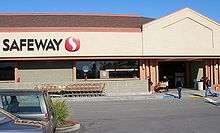

- "Since We're Neighbors, Let's Be Friends" (1972 – 1979) was probably the first Safeway advertising campaign to make use of a singalong jingle. This slogan was used by the U.S. stores until July 16, 1979, when the "Everything" slogan was adopted.
- "Everything You Want from a Store and a Little Bit More" (1979 – December 1981) was the campaign launched on July 16, 1979, and was adopted, perhaps, to reflect the image of Safeway stores as "one stop shopping centers." This campaign was used through December 1981, although it was in use in the UK into the 1990s.
- "Today's Safeway: Where You Get a Little Bit More" (January 1982 – 1983) was the first Safeway ad campaign to make use of the company's new "ribbon leaf" logo.
- "America's Favorite Food Store" (1983 – 1986)
- "I Work an Honest Day and I Want an Honest Deal" (1985 – 1987) and "America's favorite food store" tagline were used with this campaign through 1986, until the buyout and divestitures, which reduced the store count and made the "America's favorite" line inaccurate; it also featured a song.
- "Nobody Does It Better" (1992 – late 1990s) — This campaign is unique for being adapted from a pop song. In this case, the song was a hit for Carly Simon in 1977. Simon sang it as the theme song to 1977's James Bond movie, The Spy Who Loved Me. The 1993 version used in the commercials was recorded by R&B Grammy Award winning singer Patti Labelle.
- "Giving Our Best" (2001–2005)
- "Vons is Value" (mid-to-late 1990s) was used only for Vons stores in Southern California. This was the first Vons ad campaign since Safeway took over ownership of the chain.
- "Ours Is Bigger Than Yours" (mid-1990s), in reference to the expansion of produce departments in Northern California.
- "Delivering Our Best" (late 1990s – 2005) was used only for grocery delivery
- "Ingredients for life" (2005 – 2015)
- "fresh to your door" (2012 – present) used only for grocery delivery
- "It's Just Better" (2015–present) used by both Albertsons and Safeway as a combined company.
Safeway corporate information
Safeway ATM Network
The Safeway ATM Network, run for Safeway by Cardtronics, operates in Colorado, Oregon, Wyoming and Washington. Typically, one machine is located near the front of each store. Cirrus, Plus, Star, and NYCE are on the network. The network was started in late 1998 in Denver and was expanded to Wyoming, Washington, and Oregon.
Support offices
- California
- Pleasanton, California ( Headquarters), Corporate Call Center, IT Support Services, Retail Pricing
- Colorado
- Denver, Colorado (Offices,Safeway Security,Trucking)
- Arizona
- Phoenix, Arizona (Offices, Accounting Offices, IT)
- Philippines
- Manila, Philippines (IT Support Services)
Safeway Category Optimization Process
Safeway transitioned from regional control of its product assortments to national category management, known as the Safeway Category Optimization Process (SCOP). With all dry grocery corporate buying done from Safeway's Pleasanton offices, it is said it will increase representation of manufacturers by experienced sales professionals with extensive product and category knowledge. Corporate produce buying offices are located in Phoenix, Arizona. This will mean consistency across the Safeway chain, meaning one could go into a store in Winnipeg or San Francisco and find the same products at the same price, as all negotiation is now done at the corporate level.
Animal welfare concerns
In 2012, Mercy for Animals conducted an undercover investigation at Christensen Farms, a pork supplier to Safeway, Walmart, Costco, Kroger, and Kmart.[44] Before the public release of Mercy For Animals' investigation at Christensen Farms, Safeway announced it would begin requiring pork suppliers to phase out gestation crates.[45][46]
In 2008, Greenpeace started ranking America’s major supermarket chains on their seafood sustainability practices because, according to Phil Radford, Greenpeace U.S. CEO, "three quarters of global fish stocks are suffering from overfishing,[47] and 90% of top marine predators are already gone."[48][49] Criteria included the number of threatened fish species supermarkets sold, their seafood purchasing policies, and ocean legislation policies it supported.[50] Greenpeace annual Carting Away the Oceans (CATO) report ranks supermarkets on a scale of 1 to 10, with 1 being least sustainable with seafood policies and 10 being the most sustainable with seafood policies. Safeway ranked second best (7.1 out of 10) on the 2013 CATO Report by ensuring that its store brand of canned tuna was sustainably fished and by lobbying for science-based ocean conservation policies.[51]
Safeway music
Safeway music is provided by InStore Broadcasting Network. The satellite network also beams commercials and advertisements for Safeway products and brands that play intermittently with the music.
See also
References
- ↑ "Safeway Fact Book". Safeway. 2013. Retrieved 2013-12-16.
- ↑ "Our-Story". Safeway. Archived from the original on 2015-05-03. Retrieved 2015-04-28.
- ↑ Perkins, Edwin J. (November 2006). Wall Street to main street: Charles Merrill and middle-class investors. Cambridge University Press. p. 111. ISBN 9780521027793.
- 1 2 Safeway Annual Report 1966, p2
- ↑ "Safeway stock out tomorrow". Los Angeles Times. November 14, 1926. p. 17. (subscription required (help)). Alternate Link via ProQuest.
- ↑ "Denies Kroger-Safeway Merger". Wall Street Journal. October 1, 1929. p. 4. (subscription required (help)). Alternate Link via ProQuest.
- ↑ "Safeway Sells Hawaiian Stores". Wall Street Journal. January 28, 1935. p. 12. (subscription required (help)). Alternate Link via ProQuest.
- ↑ Supermarket News, December 10, 2001
- ↑ Foran, Max (1982). Calgary, Canada's frontier metropolis : an illustrated history. Windsor Publications. p. 296. ISBN 0-89781-055-4. Retrieved 2013-10-22.
- ↑ Safeway annual report 1959, p4
- ↑ Safeway Annual Report 1961
- ↑ Safeway Annual Report 1966, p10
- ↑ Pool v. City of Oakland, 42 Cal. 3d 1051 (1986).
- ↑ Groves, Martha (August 30, 1988). "The Wait Is Over: Vons Acquires Safeway Stores". Los Angeles Times.
- ↑ Johnson, Kelly (October 8, 2000). "Safeway motors up to sell gas in Roseville". Sacramento Business Journal. Retrieved 2014-01-21.
- 1 2 Sandoval, Greg (February 1, 2002). "Grocers make another go at home delivery". CNET.
- ↑ Waters, Jennifer (July 18, 2007). "Safeway shares jump on rumor of Sears Holdings' buyout". MarketWatch. Retrieved 2014-01-21.
- ↑ Lee, Michelle (2013-03-06). "Gabby Giffords returns to Tucson shooting site". USA Today. The Arizona Republic. Retrieved 2015-04-28.
- ↑ Vosburgh, Robert (July 25, 2011). "UNFI Signs Up Safeway". Supermarket News. Retrieved September 14, 2014.
- ↑ Strauss, Marina & Ladurantaye, Steve (June 12, 2013). "Sobeys to buy Safeway in $5.8-billion deal". The Globe and Mail. Retrieved June 12, 2013.
- ↑ "Sobeys completes purchase of Canada Safeway". CNW Group (Press release). November 4, 2013.
- ↑ Wohl, Jessica (October 12, 2013). "Dominick's to be sold or closed as Safeway exits Chicago". The Christian Science Monitor. Reuters. Retrieved 2014-01-21.
- ↑ Gallagher, Mari (October 14, 2013). "Why Dominick's sputtered out". Crain's Chicago Business. Retrieved 2014-01-21.
- ↑ Channick, Robert (October 16, 2013). "Jewel to keep workers from 4 Dominick's stores it's acquiring". Chicago Tribune. Retrieved 2014-01-21.
- ↑ Channick, Robert (December 28, 2013). "Final closing time for Dominick's on Saturday". Chicago Tribune. Retrieved 2014-01-21.
- ↑ "Albertsons Owner to Buy Safeway for More than $9 Billion". NBC News. March 6, 2014. Retrieved 2014-05-10.
- ↑ Li, Shan (December 26, 2014). "Haggen chain to buy 146 Vons, Pavilions, Albertsons, Safeway stores". Los Angeles Times.
- ↑ "Albertsons, Safeway complete merger". Supermarket News. January 30, 2015. (subscription required (help)).
- ↑ "Safeway store coming to Altamonte Springs". Orlando Business Journal. January 11, 2016.
- ↑ Hendee, Caitlin (September 7, 2016). "9 Denver-area Albertsons stores to become Safeway's". Denver Business Journal.
- 1 2 3 4 5 6 7 8 "Safeway Brands". safeway.com. Archived from the original on January 15, 2010. Retrieved January 14, 2010.
- ↑ "Safeway Brands - Bright Green". safeway.com. Archived from the original on January 21, 2010. Retrieved January 14, 2010.
- ↑ "Safeway Brands - Mom to Mom". safeway.com. Archived from the original on January 20, 2010. Retrieved January 14, 2010.
- ↑ "Safeway Brands - Signature Cafe". safeway.com. Archived from the original on January 25, 2010. Retrieved January 14, 2010.
- ↑ "Safeway Brands - Waterfront Bistro". safeway.com. Archived from the original on January 14, 2010. Retrieved January 14, 2010.
- ↑ "Safeway ready to unveil new 'branding' campaign". Supermarket News. March 2005 – via FindArticles.
- ↑ "Safeway Grocery Delivery Service - Delivery Area Directory". Safeway. Archived from the original on 2012-02-13.
- ↑ "Sobeys bags 236 Shell stations, 20 in N.S.". The Chronicle Herald. Retrieved 29 July 2016.
- ↑ "Safeway gas bars going to Shell". Winnipeg Free Press. Retrieved 29 July 2016.
- ↑ "Safeway's Super S Story". Pleasant Family Shopping (blog). September 16, 2007. Retrieved January 10, 2011.
- ↑ Safeway Annual Report 1964
- ↑ Safeway Annual Report 1969
- ↑ Taylor, Michael (September 27, 2005). "John Benetti -- Brentwood supermarket chain owner". San Francisco Chronicle. Retrieved 2015-11-01.
- ↑ "Walmart Cruelty: The Hidden Cost of Walmart's Pork". Mercy For Animals. Retrieved 4 September 2012.
- ↑ Runkle, Nathan (July 18, 2012). "Victory! Costco and Kmart Commit to Ditching Gestation Crates Following MFA Investigation". Mercy For Animals. Retrieved 4 September 2012.
- ↑ Runkle, Nathan (May 8, 2012). "Safeway Pledges to Eliminate Cruel Gestation Crates from Supply Chain". Mercy For Animals. Retrieved 2 September 2012.
- ↑ "General situation of world fish stocks" (PDF). United Nations Food and Agriculture Organization. Retrieved 2013-11-06.
- ↑ Tremblay-Boyer, Laura; Gascuel, Didier & Pauly, Daniel (2009). "A global map of the relative impact of fishing on the biomass of marine ecosystems from 1950 to 2004". Ecopath 25 Years Conference Proceedings: Extended Abstracts. Eds. Maria Lourdes D. Palomares, et al. Vol. 17. Fisheries Centre Research Reports, 17. 2009. 132-133. Archived from the original on 2013-12-03. Retrieved 2013-11-06.
- ↑ Radford, Phil (April 18, 2011). "Protecting our oceans, one supermarket at a time". The Seek Radio. Retrieved 2013-10-13.
- ↑ "Carting Away the Oceans" (PDF). Greenpeace. June 2009. Retrieved 2013-07-20.
- ↑ "Carting Away the Oceans 7" (PDF). Greenpeace. May 2013. Retrieved 2013-11-02.
External links
| Wikimedia Commons has media related to Safeway Inc.. |